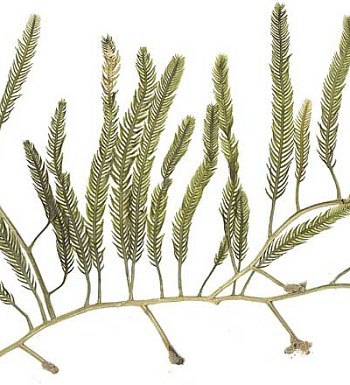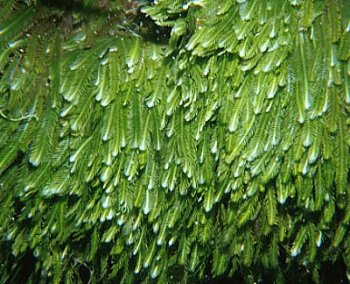

Caulerpa taxifolia in Australia
PHOTO
UPPER: Scanned herbarium specimen is about 11 cm high (From stolon to top of fronds). Photo: Alan Millar - Royal Botanic Gardens, Sydney.
LOWER: C. taxifolia in eastern Australian waters. Photo: Neville Coleman - World of Water.
RELATED TOPIC
C. taxifolia - introductions worldwide
DIVER ALERT !
An invasive, cold-water tolerant strain of the green macroalga Caulerpa taxifolia has been confirmed as growing in New South Wales waters. Unknown from mainland New South Wales, Australia, since records began with European settlement, we believe the NSW populations have been here for 5-15 years. This introduction is almost certainly the result of human activity. NSW Fisheries officers Markus Miller and Jack Hannan initially discovered the outbreak and sent specimens to Dr Alan Millar at the Botanic Gardens in Sydney for identification. This was confirmed by Prof. Alexandre Meinesz (University of Nice), who received specimens from Dr Millar, and has been involved with the outbreak in the Mediterranean since the late 1980s.
Three populations have been identified: two sites in Port Hacking, Sydney region, (Fishermans Bay and Gunnamatta Bay) that account for about 1 hectare of seabed, and almost the entire seafloor of the coastal lagoon of Lake Conjola, south of Jervis Bay in southern New South Wales. The latter site accounts for some 10 hectares.
A Caulerpa taxifolia Management Team has been set up between NSW Fisheries, the Sydney Botanic Gardens and CRIMP (Centre for Research on Introduced Marine Pests in Tasmania) so that any divers, be they recreational or commercial, who believe they have seen this species in NSW waters other than the above mentioned sites should contact either Dr Millar, Dr Darryl Grey of NSW Fisheries, or Dr Britta Shaffelke at CRIMP (see below). A full survey of Port Hacking [Sydney region] is presently underway and trial eradication methods are also being tested.
The alga is often refered to as toxic, but the toxin involved, Caulerpenyne, is a deterrent to fish and invertebrate grazing and the alga can be handled by humans without any problems. Because small fragmenst of the species can be transported and remain alive, the chances of further outbreaks along the coast are feasible. After first contacting Dr Millar, specimens collected should be placed in 70% alcohol in a snap-lock bag, placed into a jiffy bag and sent to Dr Alan Millar, Royal Botanic Gardens Sydney, Mrs Macquaries Rd, Sydney, NSW 2000.
Dr Alan Millar - (02) 9231 8136
Dr Darryl Grey - (02) 4916 3911
Dr Britta Shaffelke (03) 6232 5407
Millar, A., 2000 (September 8) Caulerpa taxifolia in Australia. [In] Sea Slug Forum. Australian Museum, Sydney. Available from http://www.seaslugforum.net/find/caultaxi2
Related messages
Re: Caulerpa taxifolia Moreton Bay, QLD
April 1, 2002
From: Cynthia Trowbridge
Dear Bill,
I was hoping that Alan Millar would answer this one since he is the person doing the work. But, since he has not yet responded, my answer is based on an abstract by Millar (Royal Botanic Gardens Sydney) & Talbot (NSW Fisheries) from the Caulerpa conference in San Diego. The full paper will be published in the Proceedings of Calif. Fish & Game probably later this year.
There have been seemingly 2 separate introductions of Caulerpa taxifolia into New South Wales (Millar & Talbot 2002) with a total of 6 populations now being known from Australia (Withgott 2002). Genetic information on the introductions was published by Jousson et al. (2000).
Native Caulerpa taxifolia occurs in Australia as far south as Southport, QLD and at Lord Howe Island (Millar & Talbot 2002). Thus, I think the Morton Bay population is thought to be native. To make it really complex, northern Australia is thought to be the probable original source of the algal material cultured in Europe; the modified cultured strain is now known as the "aquarium strain" of C. taxifolia.
As far as I can learn, no one in Australia or Calif. has really looked to see if there have been sacoglossan grazers associated with native vs. introduced Caulerpa taxifolia. In California, research scientists were not permitted access to the algal incursions for over a year (see Withgott 2002) despite the issues of sacoglossan herbivory that have clear bearing on the topic. Access was denied because the invasive alga unfortunately invaded a lagoon that was privately owned (in contrast to most other U.S. coastal regions). The folks involved in the eradication efforts are not trained scientists so there has been a large and serious communication gap (see Science paper).
In my talk at San Diego (Trowbridge 2002a), I discussed the implications of Placida spp. and Elysia spp. in switching diets from native hosts to the introduced Codium fragile ssp. tomentosoides on European and Australasian shores. I also discussed briefly the sacoglossan spp. that are possible candidates for feeding on Caulerpa taxifolia (aquarium strain) on NE Pacific shores. All that we know about these species is summarized in my recent review (Trowbridge 2002b); none of the sacoglossan species are yet known from California -- probably as there is no native Caulerpa so far north.
A major issue with studying pests is legal access for scientists. Most marine labs do not treat outflowing seawater so cannot ethically or legally hold pest species, even for scientific research. Thus, sacoglossan herbivory experiments in labs are often not permitted unless under a quarantine system with subsequent treatment of seawater, algae, and slugs.
With the Mediterranean species, sacoglossan herbivory experiments can be conducted with native Oxynoe or Lobiger spp. in the field or lab. Experiments with introduced, potential biological control sacoglossan species must be conducted according to internationally recognized guidelines in the lab. Field trials are only permitted if, and when, internationally recognized criteria have been met.
• Jousson, O. et al. (2000) Invasive alga reaches California. Nature 408:157.
• Millar, A. & Talbot, B. (2002) The introduction of Caulerpa taxifolia in New South Wales, Australia. Proc. International Caulerpa taxifolia Conference, San Diego, CA in Jan. 2002.
• Trowbridge, C.D. 2002a. Invasion ecology of Codium fragile ssp. tomentosoides: Implications for Caulerpa taxifolia incursions. Proc. International Caulerpa taxifolia Conference, San Diego, CA in Jan. 2002.
• Trowbridge, C.D. 2002b. Northeastern Pacific Sacoglossan Opisthobranchs: Natural history review, bibliography, and prospectus. The Veliger, 45:1-24.
• Withgott, J. (2002) California tries to rub out the monster of the lagoon. Science, 295: 2201-2202.
Hope this answer helps clarify a bit.
Cordially,
Cynthia
trowbric@onid.orst.edu
Trowbridge, C., 2002 (Apr 1) Re: Caulerpa taxifolia Moreton Bay, QLD. [Message in] Sea Slug Forum. Australian Museum, Sydney. Available from http://www.seaslugforum.net/find/6650Caulerpa taxifolia Moreton Bay, QLD
March 27, 2002
From: Jan Drexel
Dear Bill,
I'm a student from Germany and I'm interested into the question about possible control agents for Caulerpa taxifolia in Moreton Bay, Australia, off Brisbane. There the Caulerpa taxifolia alga occurs, but apparently without taking over. There seem to be some controlling factors, e.g competitors or grazers. Couldn't this be interesting for the problem we have in Europe?
Regards,
Jan Drexel
jandrexel@hotmail.com
Drexel, J., 2002 (Mar 27) Caulerpa taxifolia Moreton Bay, QLD. [Message in] Sea Slug Forum. Australian Museum, Sydney. Available from http://www.seaslugforum.net/find/6526Dear Jan,
At the risk of getting a bit away from sea slugs, my understanding is that the Caulerpa taxifolia in Moreton Bay is a naturally occurring population and so is in balance with its environment, while the population which is causing problems in the Mediterranean and elsewhere, is a genetically altered 'clone' which 'evolved' in aquarium conditions, that tolerates temperate waters, breeds fast, and seems to have no natural predators, or at least no predators which affect its growth. I don't know if we know what controls the natural populations of C. taxifolia but I guess like most natural populations it will be a complex mixture of biological and physical factors. The way the Mediterranean clone form is acting suggests that natural populations aren't likely to give us many clues on how it can be controlled - but I am not a plant ecologist and would prefer participants at the recent conference Cynthia Trowbridge attended in San Diego, to comment.
Here is an interesting note:
At the Australasian Society for Phycology and Aquatic Botany Conference at Heron Island, North Queensland, September 2001, evidence was presented showing that Caulerpa taxifolia occurs naturally in tropical and subtropical Australia, with records going back 100 years. One poster by researchers from CSIRO and AIMS reported on genetic research that showed that at least two of the recent 'invasions' in southeastern Australia were most likely to have originated from populations living on the Great Barrier Reef and Moreton Bay in southern Queensland. This is not to say that the 'rogue' algae in the Mediterranean is not a real threat, but it does suggest that the temperate 'invasions' in south-eastern Australia may not be comparable.
• Schaffelke, B., Murphy, N. & Uthicke, S. (2001) Caulerpa taxifolia in Australia - using genetic tools to explore sources of putative introductions. Poster Presentation: Australasian Society for Phycology and Aquatic Botany Conference, Heron Island, North Queensland, September 2001
Best wishes,
Bill Rudman
Caulerpa taxifolia in eastern Australia
September 10, 2000
From: Alan Millar

Dear Bill,
I note you already have some discussion on the invasive algal pest Caulerpa taxifolia on the Sea Slug Forum. I would be grateful if you could publicise the discovery of populations in New South Wales, eastern Australia.
Photo: Neville Coleman - World of Water
If possible we would like to try and control its spread. If any divers in eastern Australia find a seaweed that looks like this could they have a look at the information page I have provided and contact me.
Thanks for your help,
Alan Millar
Royal Botanic Gardens, Sydney.
Alan_Millar@rbgsyd.gov.au
Millar, A., 2000 (Sep 10) Caulerpa taxifolia in eastern Australia. [Message in] Sea Slug Forum. Australian Museum, Sydney. Available from http://www.seaslugforum.net/find/2999